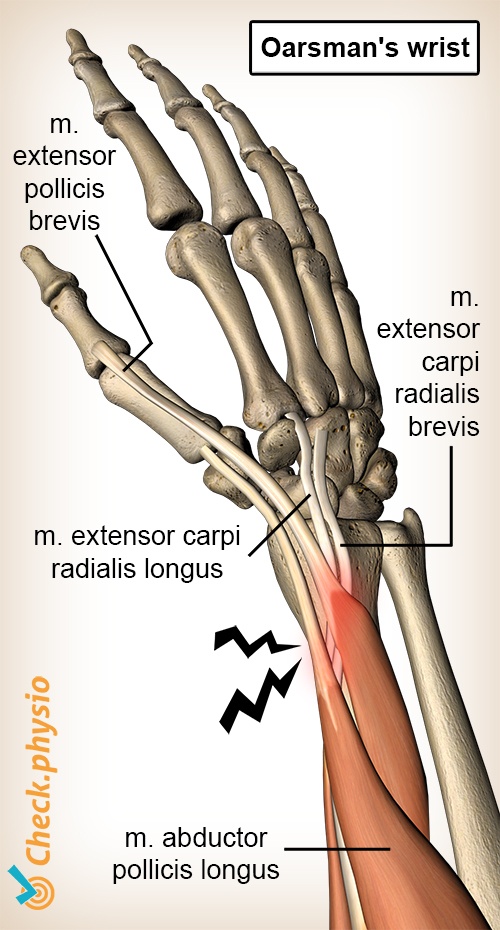- Conditions
- Oarsman's wrist
Oarsman's wrist Intersection syndrome / crossover syndrome / oarsman's wrist
Introduction
Oarsman's wrist is a painful inflammation of the forearm that is caused by friction occurring at the site where four muscles of the forearm cross over each other. It's a common symptom among rowers (oarsmen). People who flex and extend the wrist frequently and forcefully are also at increased risk.
The presentation of oarsman's wrist is very similar to that of De Quervain's disease. Both conditions have a very similar pain location and are difficult to distinguish from each other.

Description of condition
Two extensor muscles of the wrist cross two extensor muscles of the thumb at a site approximately two or three inches above the wrist joint toward the elbow. The tendons of these muscles lie close to each other. Each tendon is covered by a slippery sheath, which ensures that the tendons glide over one another easily. With oarsman's wrist, we suspect that this covering - also referred to as the "tendon sheath" - is inflamed.
The muscles that cross each other are the extensor carpi radialis longus, the extensor carpi radialis brevis, the extensor pollicis brevis and the abductor pollicis longus (see image).
Cause and history
Repeated forceful flexing and extending of the wrist is considered to be one of the causes. As a result, people who row, lift weights, do gymnastics or play a racket sport have an increased risk of developing oarsman's wrist.
Signs & symptoms
- Pain on the upper side of the wrist or forearm, a few inches above the wrist joint on the thumb side.
- Several movements can cause pain to the wrist, for example; bending, stretching and grasping objects.
- Sometimes this may be accompanied by a mild swelling or thickening on the upper side of the forearm.
- When flexing and extending the wrist, there may be a crackling or crunching sensation at the site where the tendons cross.
Diagnosis
After an interview and a physical examination by a healthcare professional, the cause of the complaints is usually clear. During the physical examination, the wrist muscles are tested in various positions. Additional research is rarely necessary.
Treatment and recovery
The first steps are to determine the cause and to prevent overuse. Relative rest will alleviate the symptoms in most cases. If the symptoms do not disappear, there are a number of options:
- Immobilization of the wrist and thumb using a splint or cast.
- Corticosteroid injection into the tendon sheath.
- In exceptional cases, the inflamed tissue can be removed surgically. This is rarely necessary.
Exercises
Take a look at the online exercise program with exercises for oarsman's wrist.
More info
You can check your symptoms using the online physiotherapy check or make an appointment with a physiotherapy practice in your locality.
References
Verhaar, J.A.N. & Linden, A.J. van der (2005) Orthopedie Houten: Bohn Stafleu van Loghum.
Parmelee-Peters, K., Eathorne, S.W. (2005) The wrist: common injuries and management Prim Care. 2005 Mar;32(1):35-70.
Gerritsen, B.J. & Heerkens, Y.F. (2004) Anatomie in vivo van het bewegingsapparaat Maarsen: Elsevier gezondheidszorg.
